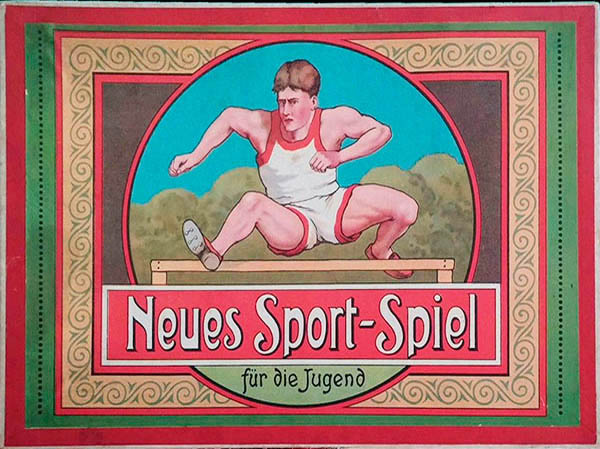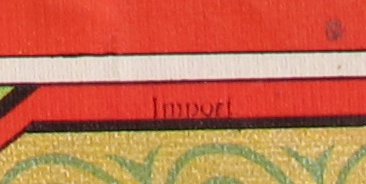
VEM FAR MED?
Sweden, ca. 1920

Old unbranded Swedish game. Though it is obviously quite old, and some elements look like those of a turn-of-the-century game, I would say it is not as old as that. I received the game along with a very similar sports game ("Nytt sport-spel", see below), which has the same kind of box and boards, very similar game tokens (in fact the cyclist token is exactly the same as the red cyclist in "Vem far med?") and exactly the same game money. I have thus all the element to believe that both games are contemporary.

The game is a betting game of goose. Players get 10 "game marks" at the beginning of the game. Whenever they fall on squares with blue numbers (excepting squares 99 and 100) they double the value of the throw. On squares with red and blue numbers, players get two extra marks from the pot. When players fall on red-numbered squares they pay two marks to the pot and go back to the square where the turn began.
Furthermore, a player falling on square 43 must pay a fine of one mark to each player and miss two turns, and a player who falls on square 95, breaks his bike ansd must leave the game. You need an exact throw to end the game (or else you go back the excess numbers thrown).
The winner of the game takes the pot, but gives 10 marks to the second player.
Question: what's the use of playing with game money?

Notice the XIXth century looking riders. Notice also the american flag.


The tin riders could be turn-of-the-century (though the bicycles look a little like motorbicycles, don't they?)



These look like bicycles!

Game marks.

Here is the Nytt sport-spel I mentioned above. As I said, it has the same kind of box and boards, very similar game tokens and exactly the same game marks. I have thus all the element to believe that both games are contemporary. However, some elements pictured on the board (specially the car and the plane) are not as old as expected.



UPDATE SEPTEMBER 2024:

Siegfried L. signals that this game was also released in Germany under the name Neues Sport-Spiel für die Jugend. He tells me that the Swedish version is probably a copy of the German one and not the other way around. One of the reasons he gives is that the empty spot on the Swedish box below the title of the game, where the German game has "für die Jugend", is unnatural, and that the German letters are more elaborated (or, to put it another way, the Swedish letters are a simplified version, which may indicate a copy). Of course, these are not conclusive arguments.

On the other hand, Sigfried also points out something that had escaped my eye: On the bottom right corner of the "Vem Far Med?" box illustration is a small word "Import" half-hidden in the grass. Thus, the game was not made in Sweden. It might be a German import.

Of course, after reading Siegfried's comments, I checked my "Nytt Sport Spel" box, and the word "Import" was there too. So Siegfried's theory that these games are German sounds quite plausible, and the Swedish versions might even have been made in Germany and exported to Sweden.
In this case, of course, we expect to find the German original version of the Vem Far Med game, which might even have actual cyclists (rather than motorcyclists, which might have been added only to the export version). And though I still believe these Swedish imports to be from the 1920s, the original German game might be older (and it looks like it is an earlier game: the moustached rider on square one looks like Maurice Garin, doesn't he?)
Of course, any further information about these or similar
games will be welcome.
Thanks to Thomas Engel for the tip that led me to them.
Thangs Siegfried for your comments.
 |
 |
 |
 |
 |
|
CULTURE IDEAS |
TOTUM REVOLUTUM THUMBNAILS |
NAMES ALPHABETICAL |
CATEGORIES LISTS |
WHAT'S NEW BLOG |